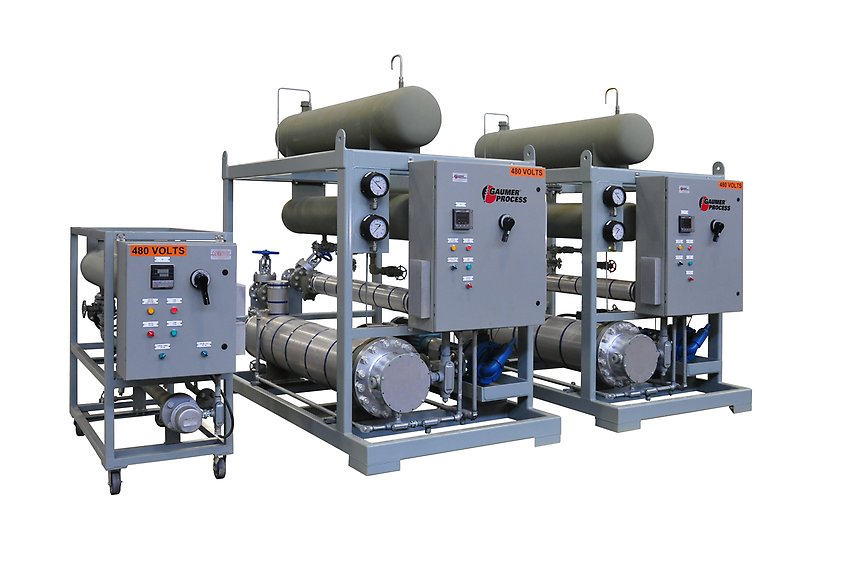Can DVS Heat Transfer Systems Help You Exceed Environmental Compliance Standards?
Wiki Article
Innovations in Heat Transfer Systems: What You Required to Know for Optimum Performance
Advancements in Heat transfer systems are transforming efficiency across numerous sectors. Advanced materials like graphene and nanofluids guarantee considerable renovations in thermal conductivity. The integration of IoT and machine learning supplies possibilities for real-time monitoring and improved energy efficiency. Nonetheless, the landscape of thermal monitoring is rapidly advancing (DVS Heat Transfer Systems). Recognizing these growths is necessary for attaining suitable system efficiency and sustainability in the future. What particular advancements are forming this change?Emerging Products for Improved Heat Transfer

Advanced Heat Exchanger Layouts
While traditional Heat exchangers have offered their purpose in various applications, advanced layouts are now emerging to fulfill the boosting demands for efficiency and performance. These cutting-edge layouts, such as plate, shell-and-tube, and finned-tube Heat exchangers, incorporate improved surface area locations and enhanced circulation patterns to boost thermal transfer rates. In enhancement, portable styles allow for lowered room requirements without endangering performance. Advanced products, such as composites and corrosion-resistant alloys, additionally improve durability and efficiency under severe problems. Simulation innovations and computational fluid characteristics are progressively utilized to refine these layouts, guaranteeing peak Heat transfer qualities. As markets look for to decrease power usage and maximize output, the adoption of advanced Heat exchanger designs is crucial in attaining these goals.The Duty of Nanotechnology in Heat Transfer
Nanotechnology plays a vital duty in boosting thermal conductivity within Heat transfer systems. By adjusting products at the nanoscale, researchers have attained substantial improvements in energy effectiveness. These improvements not only optimize performance however likewise add to even more sustainable energy remedies.Enhanced Thermal Conductivity
Considerable advancements in thermal conductivity have arised with the application of nanotechnology, reinventing Heat transfer systems throughout numerous sectors. By including nanoparticles into Heat transfer liquids and materials, researchers have actually achieved amazing boosts in thermal conductivity. These nanoparticles, such as carbon nanotubes, graphene, and steel oxides, improve the Heat transfer properties as a result of their high area and unique thermal qualities. The resulting composites display boosted efficiency in applications varying from electronics cooling systems to renewable resource technologies. Moreover, the ability to customize the dimension, form, and composition of nanoparticles permits optimized thermal administration options. Therefore, nanotechnology proceeds to play a pivotal duty in the development of extra effective and efficient Heat transfer systems, leading the way for boosted industrial applications.
Energy Performance Improvements

Assimilation of IoT in Heat Transfer Systems
The combination of IoT in Heat transfer systems introduces the implementation of wise sensing units that enhance functional performance. These sensing units make it possible for real-time data tracking, enabling instant modifications and optimizations. This technological development has the potential to significantly enhance efficiency and energy monitoring in Heat transfer applications.Smart Sensors Execution
As Heat transfer systems develop, the assimilation of wise sensing units with the Internet of Things (IoT) has arised as a transformative strategy. These sensing units enable real-time tracking of flow, temperature level, and stress rates, enhancing system performance and dependability. By collecting and transmitting data, they help with proactive maintenance, lowering the risk of system failings. Additionally, clever sensing units add to energy savings by refining operational specifications based on environmental problems. Their capacity to evaluate anomalies and trends permits educated decision-making, making certain peak performance of Heat transfer systems. As markets progressively adopt this modern technology, the application of clever sensors stands to change exactly how Heat transfer systems are handled, leading the way for greater sustainability and enhanced efficiency end results.Real-Time Information Tracking
Just how can real-time information keeping track of enhance the efficiency of Heat transfer systems? By integrating Web of Things (IoT) technology, Heat transfer systems can take advantage of constant information collection from wise sensing units. This real-time monitoring permits prompt evaluation of pressure, temperature, and flow prices, allowing operators to identify inefficiencies quickly. click this site Consequently, adjustments can be made to enhance efficiency, minimize energy intake, and expand equipment lifespan. In addition, anticipating maintenance can be implemented, minimizing unanticipated downtime and costly repairs. The ability to envision performance metrics through dashboards enhances decision-making, cultivating a positive method to system management. Eventually, real-time data keeping track of not only boosts operational efficiency however also i thought about this adds to sustainability goals within commercial processes.Energy Efficiency and Sustainability Trends
Energy efficiency and sustainability fads are improving the landscape of Heat transfer systems, driving advancement and conformity throughout various markets. Organizations are progressively focusing on energy-efficient designs to decrease functional costs and lessen environmental effects. The combination of eco-friendly energy sources is coming to be more common, enabling Heat transfer systems to operate sustainably while meeting regulatory needs. Furthermore, developments in modern technologies and products promote lower power intake and enhance overall performance. Lifecycle assessments are likewise obtaining traction, enabling companies to examine the ecological effect of Heat transfer systems from manufacturing to disposal. This concentrate on sustainability not only supports company responsibility however also placements organizations competitively in a market where customers increasingly favor eco-friendly services. Energy efficiency and sustainability stay vital factors to consider for future developments in Heat transfer technology.Advancements in Thermal Management Solutions
While the need for effective Heat transfer remains to climb, technologies in thermal administration solutions are emerging to address both efficiency and sustainability difficulties. Advanced materials, such as stage modification products and nanofluids, are being created to improve Heat transfer performance - DVS Heat Transfer Systems. These materials improve thermal conductivity and enable for better temperature level law in numerous applications. Additionally, modern technologies like energetic thermal control systems are obtaining traction, allowing real-time modifications to take care of Heat circulation successfully. These systems add to energy financial savings and decrease the ecological influence of thermal procedures. The integration of IoT in thermal administration assists in tracking and anticipating upkeep, making certain maximized performance and longevity of Heat transfer systems. Generally, these technologies represent substantial strides toward more lasting thermal administration techniquesFuture Directions in Heat Transfer Innovation
Emerging improvements in thermal management solutions signify a promising future for Heat transfer innovation. Scientists are increasingly concentrating on establishing products with remarkable thermal conductivity and enhanced energy effectiveness. Advancements such as nanofluids, which include suspended nanoparticles, use significant improvements in Heat transfer efficiency. Additionally, the combination of wise products that adjust to differing temperature problems is getting traction, enabling for even more responsive and efficient systems. The rise of additive manufacturing techniques is additionally allowing the layout of intricate Heat exchanger geometries that maximize fluid flow. Moreover, the application of device discovering formulas is prepared for to reinvent the optimization of Heat transfer systems, assisting in predictive maintenance and efficiency enhancement. Jointly, these advancements are poised to transform the landscape of Heat transfer innovations in different markets.
Often Asked Questions

Exactly how Do I Select the Right Heat Transfer System for My Application?
Picking the appropriate Heat transfer system entails assessing application demands, consisting of temperature ranges, liquid homes, and efficiency requirements. Examining system types, upkeep factors to consider, and cost-effectiveness also plays YOURURL.com a vital duty in making an informed choice.What Are the Upkeep Needs for Advanced Heat Exchangers?
Maintenance requirements for sophisticated Heat exchangers usually consist of routine inspections, keeping track of for leakages, cleansing of surface areas, and ensuring optimal flow prices. Abiding by maker guidelines guarantees reliable operation and prolongs the tools's life-span.
Exactly How Do Ecological Variables Impact Heat Transfer Effectiveness?
Ecological variables substantially influence Heat transfer efficiency. Variations in humidity, air flow, and temperature level effect thermal conductivity and convective Heat transfer, ultimately impacting system efficiency and necessitating factor to consider during the design and procedure of Heat transfer systems.What Security Criteria Put On Heat Transfer Systems?
Security standards for Heat transfer systems normally consist of standards from companies such as ASME and ASTM. DVS Heat Transfer Systems. These standards address materials, style, and functional techniques to guarantee dependability, performance, and security against risks in different applications
Just How Can I Repair Typical Heat Transfer System Issues?
Troubleshooting common Heat transfer system issues entails looking for leaks, making sure appropriate liquid flow, examining insulation stability, and validating temperature differentials. Recognizing these variables can aid preserve system effectiveness and avoid additional problems.Nanotechnology plays a necessary function in improving thermal conductivity within Heat transfer systems. Significant improvements in thermal conductivity have actually arised via the application of nanotechnology, revolutionizing Heat transfer systems across different markets. Developments in thermal conductivity via nanotechnology have paved the method for exceptional enhancements in energy performance within Heat transfer systems. Power effectiveness and sustainability trends are reshaping the landscape of Heat transfer systems, driving development and compliance throughout various markets. The combination of IoT in thermal management facilitates surveillance and predictive maintenance, ensuring maximized performance and long life of Heat transfer systems.
Report this wiki page